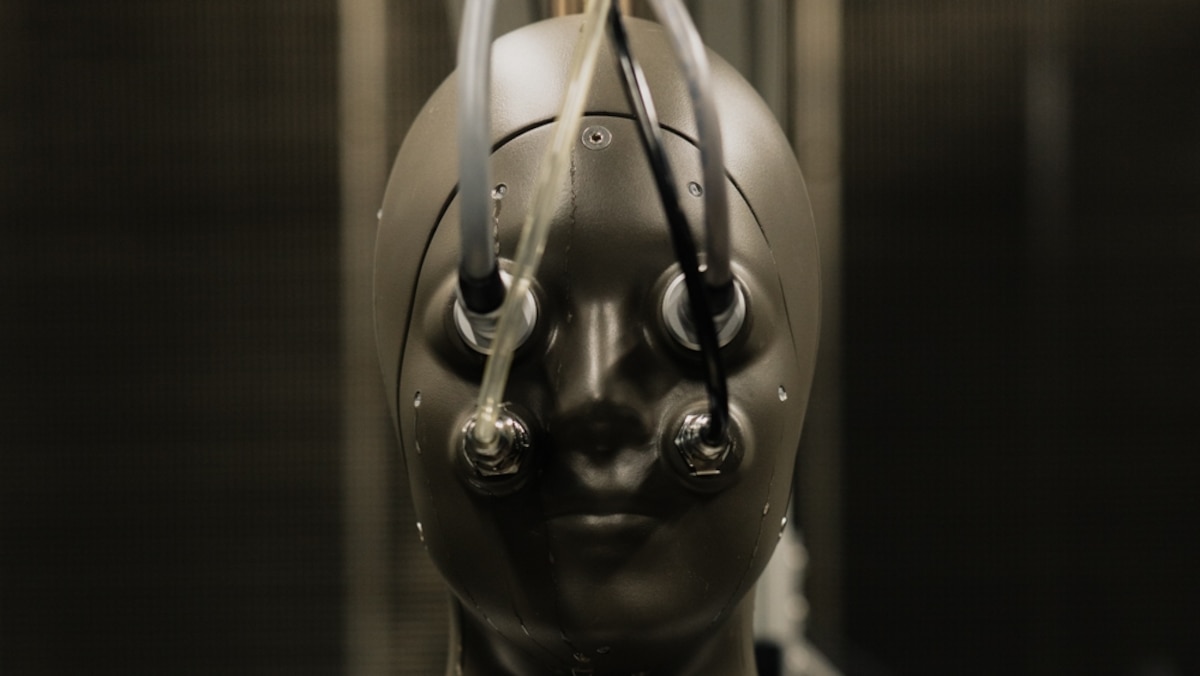Now Reading: An LED track, super shoes, and a suit made from something called Aeronodes
-
01
An LED track, super shoes, and a suit made from something called Aeronodes
An LED track, super shoes, and a suit made from something called Aeronodes

7.65 seconds.
That’s the amount of time that Kenyan Faith Kipyegon needs to shave from her world record time in order to become the first woman to run the mile in under 4 minutes.
Kipyegon, a three-time gold medalist, has spent months training for an exhibition on Thursday in Paris where she’ll take a crack at the mythic sub-four barrier. An attempt, she says, to “cement her legacy.”
The event, dubbed Breaking4, is being staged by Nike, Kipyegon’s sponsor. To help her make history, everyone from physiologists to shoe designers have rallied to find ways to help her trim every hundredth of a second possible—some of which make the run ineligible for official world records.
It’s a tricky task. The mile is short enough that small benefits have little time to accrete as they do in, say, the marathon. At the same time, the short distance means that “any glitch is magnified,” says Brett Kirby, a performance researcher at Nike.
Recently, I traveled to Nike’s LeBron James Innovation Center in Beaverton, Oregon, to learn where they’ve tried to find those elusive seconds.

The camp in Kenya that Faith Kipyegon trains at sits at 8,000 feet, which means her body makes more red blood cells than it would at sea level.
The location
Thursday’s exhibition is being staged at Paris’s Stade Sébastien Charléty at 8 PM local time. After poring over location data from around the world for months, organizers settled on the 20,000-person stadium for several reasons.
The French capital has a one-hour time difference with Kenya, where Kipyegon lives and trains, and so requires little adjustment for the 31-year-old runner. The city’s elevation is also advantageous. Paris sits at just 115 feet above sea level. Kipyegon trains at a small camp called Kaptagat nearly 8,000 feet above sea level, where the air pressure is much lower, and the blood carries less oxygen. At such elevations the human body responds by making more red blood cells, which enable it to carry more oxygen with every heartbeat, explains Rodger Kram, a professor emeritus in the Integrative Physiology Department at the University of Colorado at Boulder. As a result, “When you go down to sea level, you’ve sort of got an extra scuba tank; you can deliver more oxygen to your muscles,” says Kram.
The timing of the event was also an important factor. Based on historical data, conditions on race evening in Paris could be reasonably expected to be 68 degrees, with 50-percent relative humidity and 60-percent cloud cover, Nike researchers said, though the current weather forecast predicts slightly elevated temperatures and perhaps a little rain.
In a race as short as one mile, “The temperature and the humidity are relatively unimportant, as long as it’s reasonable,” says Kram. The more important weather choice, Kram says, is to run on a calm day, and at a calm time of day. Presumably, that’s one reason why the race will take place in the evening, as the sun sets and diurnal breezes diminish.
(Faith Kipyegon on how she’ll run a 4-minute mile—and why motherhood has made her faster)
The stadium has a state-of-the-art track, installed in 2019, that provides a runner both shock absorption and energy return. But Kipyegon’s real advantage on the oval will come in the form of a so-called Wavelight pace-setting system. Once she begins to run, 400 computerized lights built into the track’s inner curb will set an automated pace for the Kenyan—similar to the way a mechanical rabbit is used to guide greyhounds around a dog track. The lights are very effective in helping runners, says Kram. “You don’t have to think about your pacing, your effort—‘Am I going out too fast? Am I going too slow?’”
Which is a huge boon, because correct pacing is crucial. A 2014 study suggested that the most successful strategy for running a record-breaking mile time is to run all four laps at nearly the same pace, which is contrary to how many milers pace the distance. (The traditional pacing structure for each of the four laps often has been faster-slower-slowest-faster.)
A handful of places around the world have mild weather in June, sit at sea level, and feature cutting edge tracks. But there was a final, hard-to-quantify factor that tipped the scales in favor of Stade Sébastien Charléty. Kipyegon associates the track with great things: it’s where she set the 1500m world record last July.

The 3D-printed bra that Kipyegon will run in was custom-made at Nike’s LeBron James Innovation Center in Beaverton, Oregon.
Pacers
While Wavelight will show Kipyegon how fast to run, she’s also expected to be flanked by a phalanx of fellow runners known as pacers.
Their primary task is to shield her from the wind as she runs at 15 miles an hour. Drafting reduces aerodynamic drag, allowing an athlete to run faster without expending more energy. Without pacers, studies have shown, the air resistance encountered by an athlete who’s running at 4-minute-mile pace can cause their oxygen consumption to increase by as much as 5 to 10 percent.
Before the advent of fancy flashing lights on a track, pacers also set a correct pace for a runner. And they’ll still do that job for Kipyegon, which allows her to worry even less about strategy and instead simply lock into the act of running. They serve another purpose, too: The mile is an excruciating distance. The third lap has been called the loneliest minute in all of sports—when the lungs scream to stop and yet the finish line is nowhere in sight. The presence of another runner before you, pulling you down the track, can help you feel that you’re not alone in your agony.
You May Also Like
In a study published last winter in the journal Royal Society Open Science, Kram and others argued that it was possible for Kipyegon to run a mile in 3:59.37 if she utilized drafting provided by a pacer exactly four feet in front of her and a second running exactly four feet behind her. (The rear pacer pushes air into the back of the runner, propelling her ever so slightly forward, a phenomenon seen in stock car races.) At the exhibition, Kipyegon may have pacers swap in and out as the race unspools—as Kenyan Eliud Kipchoge did when he became the first person to break two hours in the marathon in 2019—or she may stick with the same group of pacers throughout. (Nike hasn’t offered any information about the pacers who will help Kipyegon or their pacing strategy).
Bespoke shoes
Kipyegon will wear ultralight track spikes that Nike has built specifically for the record attempt. Each shoe weighs about 85 grams, around 25-percent lighter than the ones she wore when she broke the mile record in 2023. (For comparison, a deck of cards weighs about 100 grams.) The upper of each spike is as light as three paperclips and is woven from a new, proprietary yarn that’s never been used in a shoe before; the resulting fabric is so thin you can see your fingers through it.
Shoe weight, or lack thereof, matters. The rule of thumb—or “rule of toe,” as Kram calls it—is that for every 100 grams pared from a shoe’s weight, the energy cost to the runner drops by about 1 percent. And each 1-percent decrease in energy cost translates to 2/3 of a percent increase in speed, says Kram, who has researched the relationship. For Kipyegon, a shoe that’s nearly 30 grams lighter than her previous shoe could reasonably be expected to make her almost 0.3 percent faster—which translates to a savings of about 0.7 seconds, he estimates.
Indeed, a study earlier this year found that trained middle- and long-distance runners wearing “super-spikes” not unlike Kipyegon’s shoes ran 1 to 2 percent faster than when they wore traditional spikes. These savings don’t sound like a lot. But Kipyegon is trying to reduce her world record time by only 7.65 seconds—and lighter shoes get her nearly one-tenth of the way there. Even more helpful than the weight savings, Kram suspects, is that Nike also bolstered the new shoe with a so-called Air Zoom unit under the forefoot (think of an ultra-springy airbag) that’s three millimeters taller than in her previous track shoe, which will boost the energy return (though Nike declined to say by how much).

The upper of each of her shoes weighs as much as three paper clips and is woven from a new yarn never-before used in a running shoe.


Kipyegon’s custom suit is covered in thousands of tiny bumps to smooth out so-called “noisy” air.
Clothes that aren’t a drag
During the race Kipyegon will wear a Nike-designed suit, leggings, and armbands featuring thousands of “aeronodes,” or tiny bumps, placed in strategic patches. The bumps are designed to smooth out “noisy” air that can subtly impede a runner, said Lisa Gibson, who works in Apparel Innovation for Nike. Under the suit, Kipyegon wear a 3D-printed bra the company designed that’s made of ultralight thermoplastic.
In his biomechanics classes he teaches about two types of drag forces that can slow a runner. One is pressure drag, which is like the wave you feel when a car drives quickly past, he says, and accounts for about 90 percent of the drag a runner experiences. “Reducing pressure drag is what the pacers are going to do,” he says.
The suit, on the other hand, addresses surface drag, or the friction between the object and the fluid it’s moving through. Counteracting surface drag is only important, though, if you’re traveling at high speed (like a luge athlete barreling down an icy course) or else in a medium with a lot of drag, such as a swimmer in a pool, he says. (Remember Speedo’s LZR Swimsuits that were so good at reducing drag that they were banned?) Nike has tinkered with drag-reducing clothing for a decade or more. And Kipchoge wore a pebbled tank top during his record-shattering run in 2019.
A spokesperson for the brand declined to say how much the shoes and the suit could be expected to contribute to reducing Kipyegon’s time. Kram is skeptical that it will do much, but, he says, if you’re trying to do anything to help “you pull out all the stops.”
Legal performance-enhancers
There are several substances approved for competition by the World Anti-Doping Agency that Kipyegon could take prior to running to shave off a few more milliseconds. Caffeine, beet-root juice, and baking soda have all been shown to boost an athlete’s performance. Kipyegon and her team have declined to say which substances she might use, if any.

The indoor track at Nike’s research lab in Beaverton, Oregon.

This machine shows where an athlete applies pressure on their feet when they run and jump, allowing scientists to create better and more efficient footwear.
So, will she do it?
Will these advancements and hacks help carry Kipyegon through the tape before the 4-minute mark?
In a white paper that appeared in April in the Journal of Applied Physiology, Kirby and other researchers wrote, “To our knowledge, there is no female athlete presently displaying the endurance parameter ratio, or other physiological characteristics, required to run a sub-4 min mile.” The authors left the door open to the possibility, however, that unnamed aids—such as pacing, shoes, baking soda—could make up the nearly eight-second difference.
Kram is more optimistic than that. “I think that if she can run in the aerodynamic pocket, whatever she’s provided with, [I] think she has a really good chance,” he said. “In the past, she has not taken full advantage of aerodynamic drafting. So I hope that she’s become a convert and is more skilled and can tuck into that little air pocket and do it.”
He added, “I think she’s gonna get really close, if not break it.”























